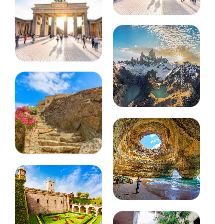Visiting the Musée du Louvre: works, opening hours & advice
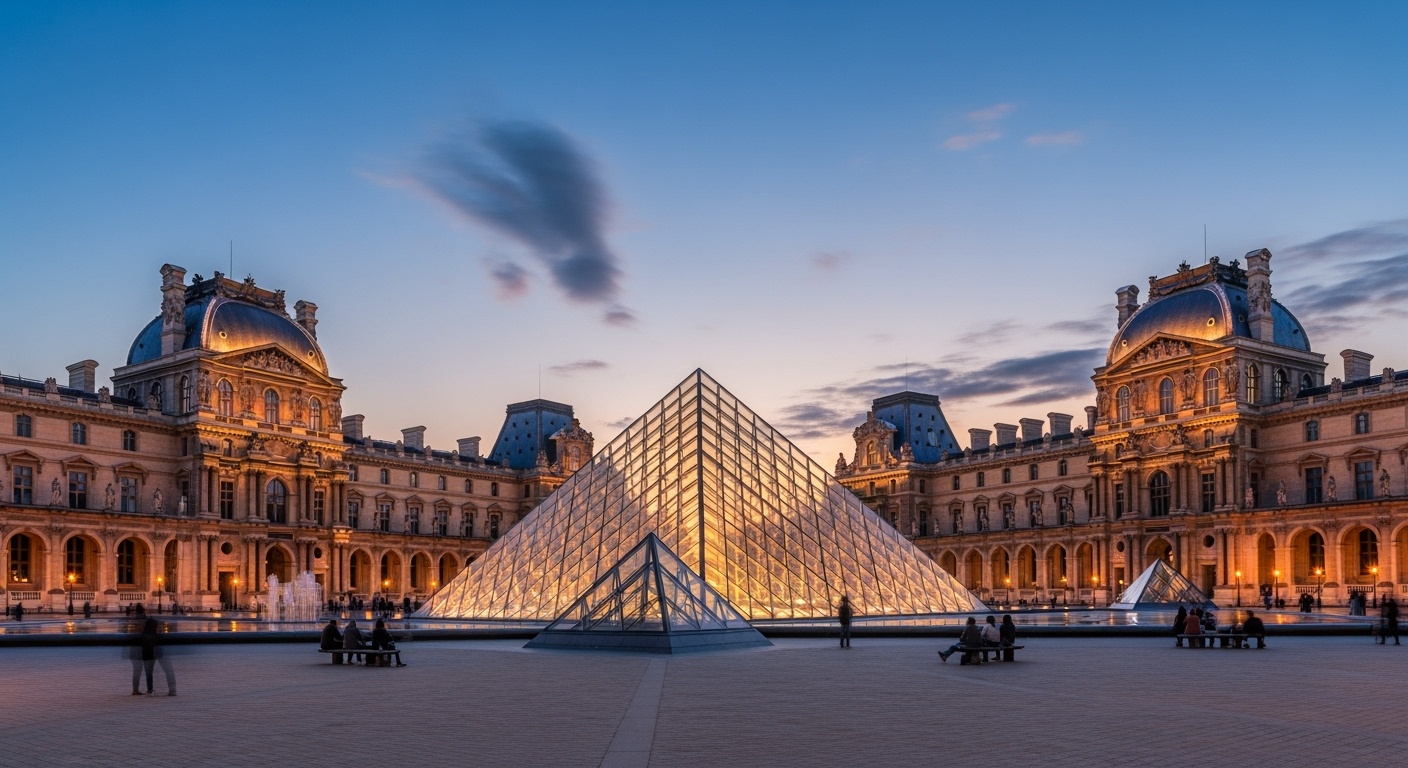
The Musée du Louvre is one of the world’s most emblematic cultural destinations. With 35,000 works displayed over 210,000 m², this former royal palace transformed into a national museum attracts almost 10 million visitors every year. From the famous Mona Lisa to the majestic Venus de Milo and the Victory of Samothrace, the Louvre brings together masterpieces that have left their mark on the history of art. This comprehensive guide will help you prepare for your visit to the Musée du Louvre, discover its must-see works and make the most of this unique experience when visiting Paris.
200 audioguided tours for cities all around the world
DownloadHistory and architecture of the Louvre Museum
The history of the Louvre begins in the 12th century with Philippe Auguste, who had a fortress built to defend Paris. This medieval fortress evolved over the centuries to become a royal residence under François I in the 16th century. The palace’s current architecture reflects this long history, blending Renaissance, classical and contemporary styles with the addition of Ieoh Ming Pei’s Glass Pyramid in 1989. In 1793, at the height of the French Revolution, the Louvre opened its doors to the public as a national museum, democratising access to the art treasures previously reserved for royalty. Today, the building covers 73,000 m² of exhibition space, divided into three wings: Richelieu, Sully and Denon.
See also the Paris guide :
- 15 historic monuments not to be missed in Paris
- 20 must-see museums in Paris
- Visit Paris in 3 days: complete weekend guide 2025
- 15 free things to do and see in Paris
- The 12 most beautiful walks in Paris to discover
- Cruises on the Seine in Paris: itineraries, fares and advice
- Top 7 best hotels in Paris
- 5 weekend ideas around Paris
Louvre opening times and prices
The Musée du Louvre is open every day except Tuesday. Opening hours are 9am to 6pm on Mondays, Thursdays, Saturdays and Sundays, with late-night opening until 9pm on Wednesdays and Fridays. The last admission is 1 hour before closing time, and evacuation of the rooms begins 30 minutes before closing time. The museum closes exceptionally on 1 January, 1 May and 25 December.
Admission to the Musée du Louvre is €22 for adults. Admission is free for under-18s and under-26s from the European Economic Area. The admission ticket gives access to the permanent collections, temporary exhibitions and the Musée National Eugène-Delacroix on the day of your visit and the day after. It is strongly recommended that you book your ticket in advance on the official website to avoid queues and to ensure you get in, as the number of visitors is limited every day.
Must-see works from the Louvre Museum
1. The Mona Lisa by Leonardo da Vinci
The Mona Lisa, painted by Leonardo da Vinci between 1503 and 1506, remains the most famous work in the Louvre and probably in the whole world. This portrait of Lisa Gherardini, wife of Francesco del Giocondo, fascinates with its enigmatic smile and revolutionary sfumato technique. On display in the Grand Gallery, behind protective glass, it attracts thousands of visitors every day. The work measures just 77 x 53 cm, which often surprises visitors expecting a larger format.
2. The Venus de Milo
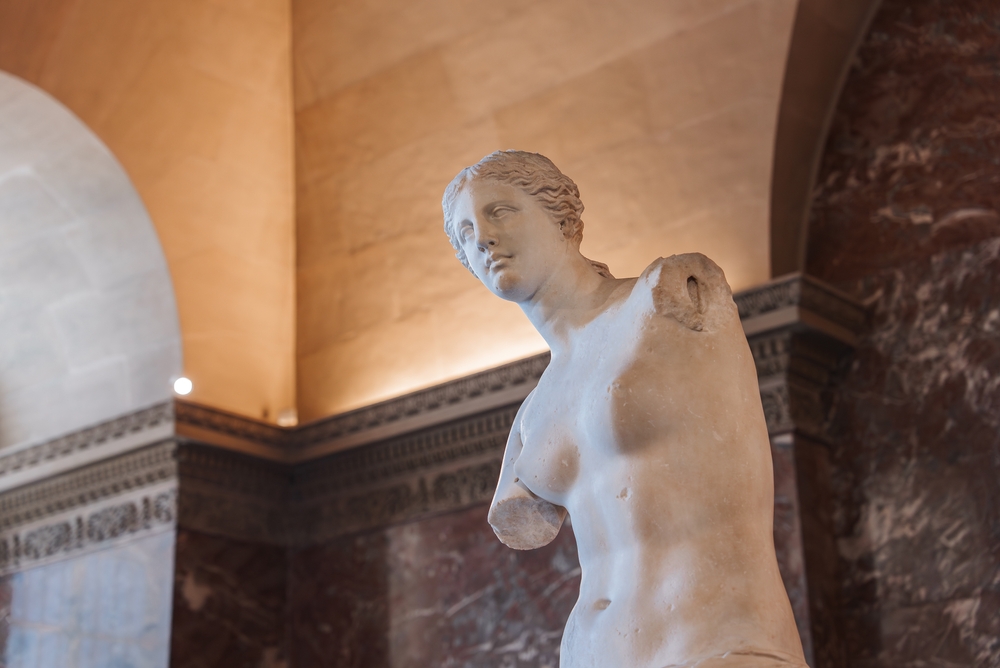
The Venus of Milo, sculpted around 100 BC and attributed to Alexandros of Antioch, represents the ideal of ancient Greek beauty. Discovered on the island of Milos in 1820, this 2.04-metre marble statue is fascinating despite its missing arms, a mystery that continues to fuel debate. On display in the Gallery of Greek Antiquities, it symbolises Aphrodite, the goddess of love and beauty. Its harmonious proportions and the delicacy of its drapery make it one of the most admired works in the museum.
3. The Victory of Samothrace
The Victory of Samothrace, dating from around 200 BC, sits majestically at the top of the Daru staircase. This 5.57-metre marble statue and plinth depict the winged goddess Nikè celebrating a naval victory. Discovered in 1863 on the island of Samothrace, it impresses with its dynamism and the effect of movement created by its sails floating in the wind. Its strategic position in the museum makes it a must-see and one of the first works to be discovered by visitors.
4. The Raft of the Medusa by Théodore Géricault
The Raft of the Medusa (1819) by Théodore Géricault marks a turning point in French art towards Romanticism. This monumental canvas, measuring 491 x 716 cm, depicts the real-life tragedy of the sinking of the frigate Méduse in 1816. Géricault conducted a veritable journalistic investigation, meeting the survivors and studying the anatomy of the bodies to depict this tragedy with striking realism. The work is shocking for its dramatic composition and its implicit political message about the incompetence of the authorities of the time.
5. Liberty Guiding the People by Eugène Delacroix
Eugène Delacroix’s Liberty Guiding the People (1830) immortalises the French revolutionary spirit. This allegory of the July 1830 revolution features Marianne, the figure of the Republic, guiding the people of Paris towards freedom. The French tricolour floats at the centre of the dynamic composition, a symbol of democratic aspiration. This emblematic work has inspired many representations of the French Republic, and even features on the old 100 franc banknotes.
Download the audio tour to discover Paris on foot and on your own
Our audio tour of Paris takes you on a journey of discovery through the French capital, including a visit to the Louvre Museum and the surrounding area. This 8.9 km tour with 18 audioguides guides you through Paris’ iconic monuments, offering an enriching perspective on the history of this exceptional city and its architectural treasures.
Departments and collections of the Louvre
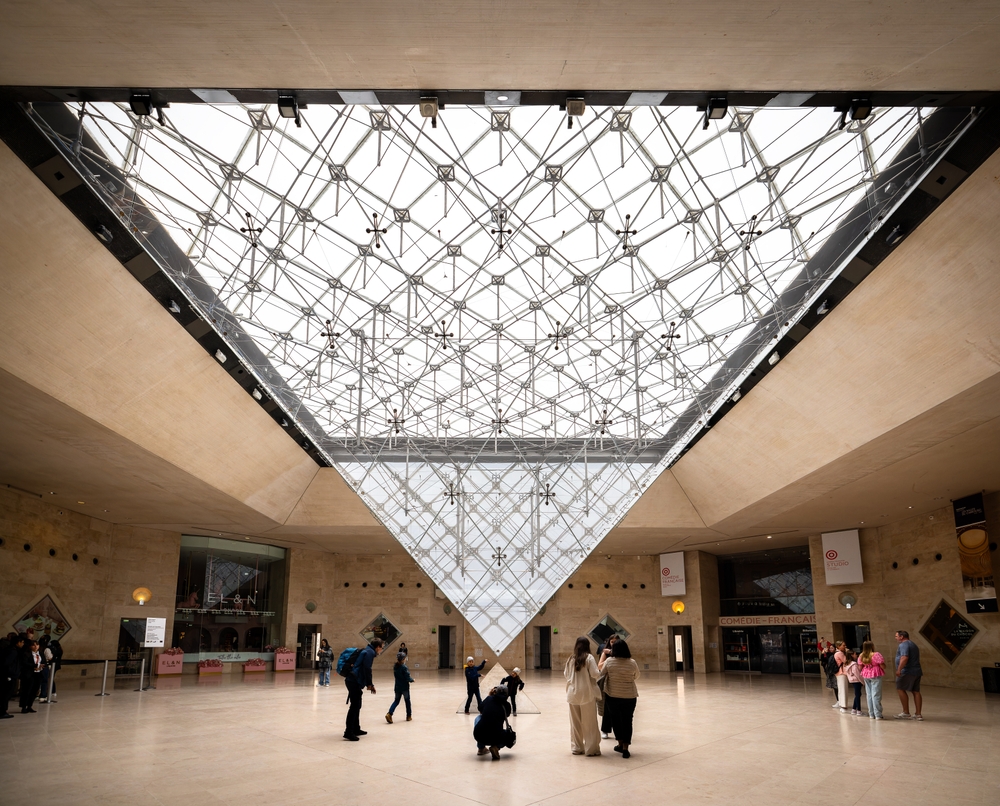
1. Oriental Antiquities
The Department of Oriental Antiquities brings together some exceptional examples of the civilisations of the Ancient Near and Middle East. Highlights include the Code of Hammurabi (circa 1750 BC), one of the earliest known pieces of written legislation, and the imposing winged bulls of Khorsabad that guarded the Assyrian palaces. These collections cover more than 8,000 years of history, from prehistory to the advent of Islam, illustrating the art of Mesopotamia, ancient Iran and the Levant.
2. Egyptian antiquities
With over 50,000 works, the Louvre’s Egyptian Antiquities collection is one of the richest in the world. The Crouching Scribe (circa 2600-2350 BC), a masterpiece of Egyptian art, captivates visitors with its striking realism. The sarcophagi, mummies, jewels and papyri retrace 4,000 years of Pharaonic civilisation. The Crypt of Osiris recreates the mystical atmosphere of Egyptian temples, while the rooms display works from the Old Kingdom to the Coptic period.
3. Islamic arts
The Department of Islamic Art, inaugurated in 2012, displays more than 1,000 works spanning 13 centuries and three continents in a modern architectural setting. From illuminated manuscripts to lustrous ceramics, from precious carpets to scientific objects, this collection bears witness to the richness and diversity of Islamic civilisation. The baptistery of Saint Louis, a masterpiece of 14th-century copperware, is a perfect illustration of the artistic exchanges between East and West.
4. French sculptures
The French Sculptures department traces the development of this art form from the Middle Ages to the 19th century. The Cour Marly houses Guillaume Coustou’s famous Chevaux de Marly, commissioned by Louis XV to adorn the Château de Marly. These monumental works, bathed in natural light, illustrate the virtuosity of French sculptors. From medieval recumbents to works by Houdon and Rude, this collection reveals the evolution of French sculptural styles and techniques over the centuries.
Practical tips for visiting the Louvre
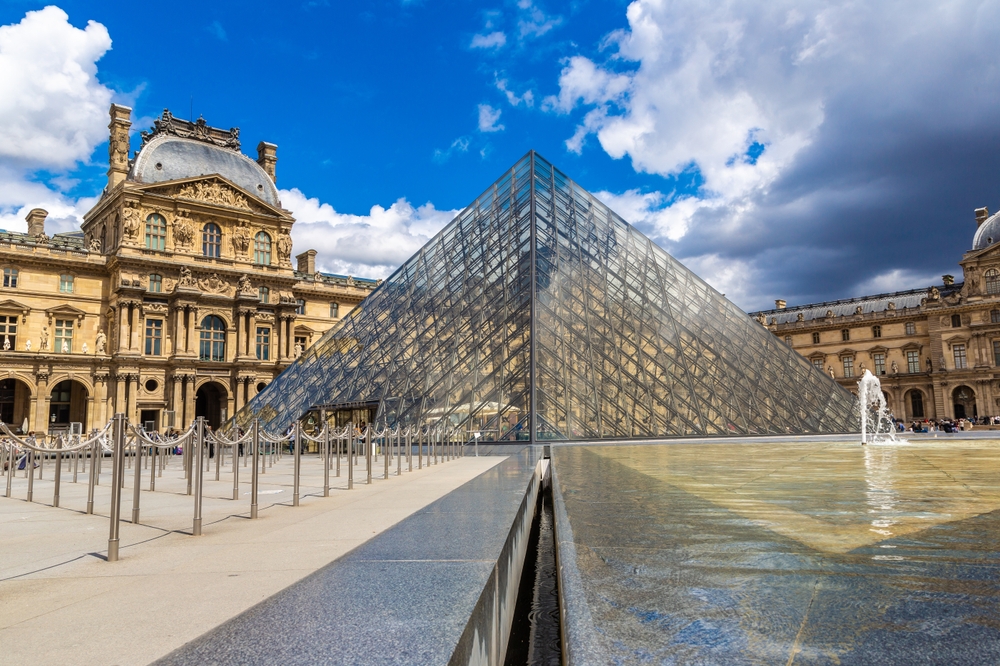
1. Best times to avoid the crowds
To make the most of your visit to the Musée du Louvre, opt for less crowded time slots. Opening at 9am, particularly on Mondays and Thursdays, offers a more serene experience. Wednesday and Friday evenings after 6pm are also an excellent option, offering a more intimate atmosphere. Avoid weekends, school holidays and the busiest afternoons. Thursday is generally the least busy day of the week.
2. Preparing your visit
Given the vastness of the museum, it is essential to plan your visit beforehand. The Louvre offers several themed tours: “Masterpieces of the Louvre” (1h30), “Le Louvre en famille” or tours by department. Download the official Louvre app or pick up a map at the entrance. Concentrate on a maximum of 2-3 departments for an initial visit lasting 3-4 hours. Don’t hesitate to use theNavaway itinerary to discover the museum’s surroundings and extend your Parisian exploration.
3. Services and facilities
The Louvre offers a number of services to enhance your experience. Audio guides (€6) are available in several languages and offer age-appropriate commentary. There is a free cloakroom where you can leave coats and bulky bags. There are several cafés and restaurants in the museum, including the Café Marly with its view of the Pyramid. Shops sell books, reproductions and souvenirs. For families, pushchairs are available and baby areas make it easier to visit the museum with young children.
4. Access and transport
The Musée du Louvre (Rue de Rivoli, 75001 Paris, rated 4.5/5 on Google for over 150,000 reviews) is easily accessible by public transport. The “Palais Royal – Musée du Louvre” metro station (lines 1 and 7) takes you directly to the entrance. RER lines A, B or D take you to Châtelet-Les Halles, a 10-minute walk from the museum. Several bus lines (21, 24, 27, 39, 68, 69, 72, 81, 95) serve the surrounding area. For those who come by car, the Carrousel du Louvre car park offers 605 paid spaces.
Additional information for the visit
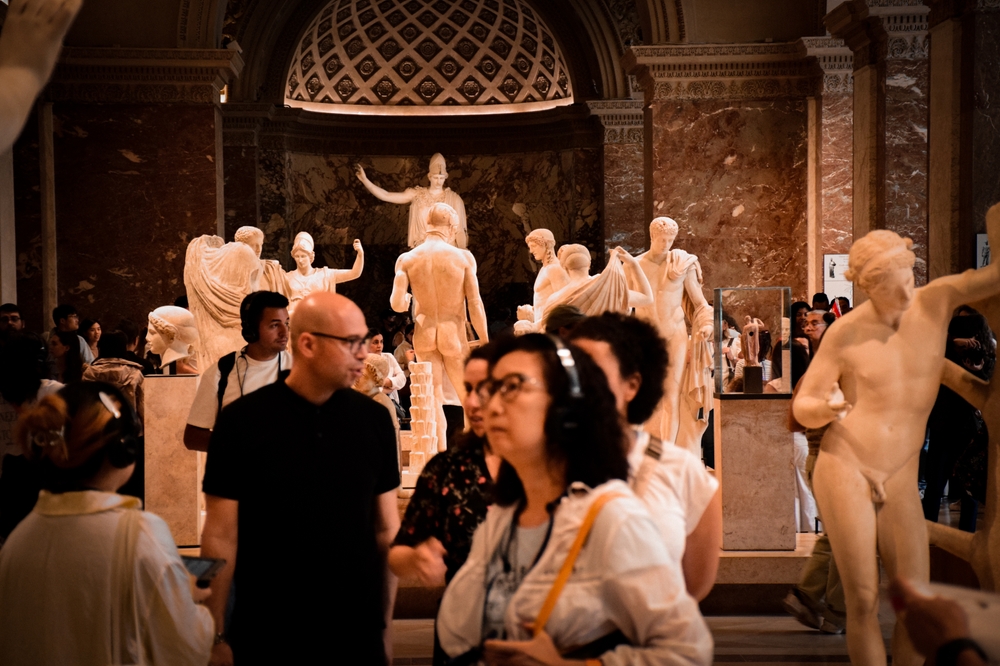
1. Recommended length of visit
For a first visit to the Louvre, allow at least 3 hours to discover the essential works. A complete visit to the permanent collections would take several days. Art lovers can spend a whole day there by combining a visit to the collections with a tour of the temporary exhibitions. We recommend taking regular breaks to avoid museum fatigue and get the most out of each work.
2. Guided tours and activities
The Louvre offers a range of guided tours (€31 with admission, €12 without). Themed tours explore specific subjects such as “The art of living in Versailles in the 18th century” or “Masterpieces from the Louvre”. Workshops for children and families make the visit interactive and educational. Lectures and shows enhance the cultural experience, with prices ranging from €5 to €49 depending on the programme. Advance booking is strongly recommended for all these activities.
3. Rules and recommendations
Certain rules must be observed when visiting the Louvre. Photographs are permitted without flash in the permanent collections, but are prohibited in front of certain works, such as the Mona Lisa. Large bags must be left in the cloakroom. It is forbidden to touch works of art or to run in the galleries. Phones must be switched to silent mode. Bring comfortable shoes as the tour involves a lot of walking on the marble floors.
In conclusion, visiting the Musée du Louvre is an exceptional cultural experience that deserves careful preparation. With its legendary works, grandiose architecture and universal collections, the world’s largest museum offers a journey through the history of art and civilisation. Thanks to the advice in this guide and theNavaway audio tour, you are now ready to discover this temple of culture in the best possible conditions. Don’t hesitate to extend your cultural discovery by exploring the architectural and historical wonders that Paris has to offer.
FAQ
How long does it take to visit the Louvre?
A first visit to the Louvre requires at least 3 hours to see the essential works. For a more in-depth visit, allow a full day. It is impossible to see everything in one go, as the museum has more than 35,000 works on display.
Do I need to book my ticket in advance?
Yes, we strongly recommend that you book your ticket in advance on the Louvre’s official website. This guarantees your entry at the time you choose and avoids long queues, particularly during the high tourist season.
When is the best time to visit the Louvre?
The best times to visit are at 9am (especially on Mondays and Thursdays) and after 6pm on Wednesdays and Fridays. For a more relaxed visit, avoid weekends and school holidays.
Can I photograph in the Louvre?
Photographs without flash are permitted in most permanent collections, but prohibited in front of certain works such as the Mona Lisa. Always check the signs before photographing a work.
Is the Louvre accessible to people with reduced mobility?
Yes, the Louvre is accessible to people with reduced mobility. Lifts, ramps and wheelchairs are available. The main entrance under the Pyramid is the most suitable. It is advisable to contact the museum before your visit to make the best possible arrangements.
200 audioguided tours for cities all around the world
Download